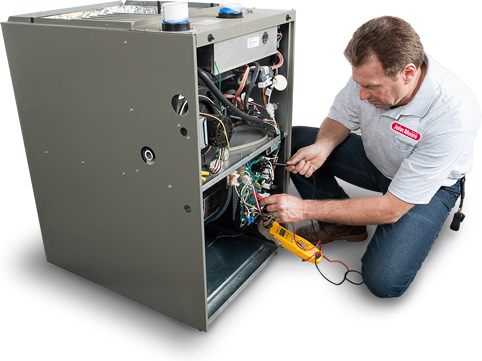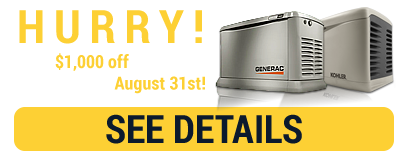
Your Complete Guide to Furnaces: Replacements, Repairs, and Maintenance

Your Complete Guide to Furnaces: Replacements, Repairs, and Maintenance
During the winter, it’s essential to run through your mental checklist—let the faucets drip, clean the gutters, and check for drafts coming through your doorways. But you may forget one of the most important preparations: making sure the furnace is in good working order for another cold season.
During the winter, it’s essential to run through your mental checklist—let the faucets drip, clean the gutters, and check for drafts coming through your doorways. But you may forget one of the most important preparations: making sure the furnace is in good working order for another cold season.
It’s easy to take the warmth generated by the furnace for granted. But if yours stops working, you’ll regret not having it tuned up. Don’t let winter’s bite catch you unprepared.
This furnace care guide will help you better maintain your system, find out when it’s time for repairs, and prepare for an eventual furnace replacement.
How Do Furnaces Work?
A furnace maintains a warm indoor atmosphere by pushing heated air into the various rooms within a structure. The warm air travels through sealed air ducts, while the heat source is usually natural gas, propane, or electricity.
Furnaces work hard and rely on numerous moving parts to deliver reliable, comfortable temperatures throughout the cold months. Your furnace’s health and performance level depend on three key factors:
- Initial installation
- Furnace inspections
- Performing necessary repairs
Furnace Inspections
The first step toward a healthy furnace is a proper inspection. You don’t have to wait until there’s a problem to schedule an inspection. Understanding your furnace’s current condition can help you plan for the future and determine whether it needs repairs.
Every property owner should maintain a yearly heating system service plan. If you haven’t had your system looked at for years, schedule an inspection as soon as possible. A professional technician can assess whether there are any critical issues to address with your furnace.
A professional inspection will include the following tasks:
- Checking the air intake and vents for signs of blockage
- Examining the vent system for potential leaks
- Testing the system’s blower
- Checking the blower door’s seal
- Assessing the condition of the heat exchanger for cracks or corrosion
Common Types of Furnace Maintenance
Issues can arise with your furnace at any time, but a yearly checkup from an expert can help prevent serious and costly repairs in the future. We recommend scheduling an inspection once per year, typically before winter hits. A qualified HVAC professional will perform the following tasks.
Clean the Airways and Test the Electronics
Your furnace’s performance depends on free-flowing air. It can’t move hot air through your home effectively if built-up dust or debris blocks its path. Annual furnace maintenance includes removing debris from around the blower. Your technician will also check the blower’s amperage draw to determine how well it’s functioning.
A furnace tune-up also includes replacing or cleaning the air filter, allowing it to draw plenty of air to heat. The technician will check your wires, calibrate the thermostat, and test the startup cycle to ensure everything works properly.
Test and Replace Moving Parts
Your technician will ensure the fan turns as it should, tightening or replacing moving parts as needed. They will look for any signs of damage to the system’s belts and lubricate moving parts.
3 Signs Your Furnace Needs Repairs
Even the most well-maintained heating system can experience issues that require repair, especially as it ages. During a maintenance service, your technician can alert you to the likelihood of repairs for the different components they examine.
Let’s take a look at the signs your furnace needs attention.
1. Trouble Starting
If your furnace doesn’t turn on, even after a few tries, potential causes include the following:
- Faulty wiring
- Damaged thermostat
- Dirty filters
- Broken heat exchanger
- Dusty flame sensor
2. Inadequate Heating
If your furnace doesn’t produce enough heat to maintain a consistent and comfortable temperature, the ductwork may have a leak, or the thermostat may be failing. Uneven heating usually indicates a problem with the ducts.
3. Higher Energy Bills
You may think higher energy bills are another impact of cost-of-living increases, but they may mean your furnace is working overtime. A sudden rise in energy costs can indicate a blockage, clogged filters, leaks in the air ducts, and other issues.
4 Signs Something More Serious Is Going On with Your Furnace
These four signs indicate a more significant problem with a furnace requiring immediate attention.
1. Loud Operation
Even a healthy furnace can make some concerning sounds—a constant whirring or an occasional hum or rattle. These noises may just call for simple maintenance. But loud banging sounds, heavy rattling, or grinding noises could point to serious issues.
2. Unpleasant Odors
When you first start your furnace up for the winter, you may notice a burning or gas smell. It’s normal for a unit to give off this odor after a period of non-use.
However, if that smell doesn’t dissipate in the first hour of use, it’s important to have the unit inspected. Lingering odors may indicate an increase in dirt and debris buildup, a gas leak, or damage to vital components. A strong and persistent gas odor is especially concerning, so turn off your furnace and contact an HVAC expert.
3. Presence of Carbon Monoxide
Carbon monoxide has no odor or color, making it a silent killer if left unaddressed. If your carbon monoxide detector goes off, get out of your home and call a professional immediately.
4. Unusual Pilot Light Color
Your furnace’s pilot light should glow blue every time it ignites. Any other color could mean the furnace or home has a ventilation problem. A discolored pilot light could also signify a carbon monoxide leak.
Is It Time for a Home Furnace Replacement?
If your furnace is over 15 years old, you’ll probably need to prepare for replacement. Sometimes furnaces can last 20+ years, but it’s rare for most models to last longer than 15.
Other indicators that replacement is in your future include failing parts, insufficient heating, and costly repairs. But the good news is that a new furnace will probably reduce your monthly energy bills, as newer models are much more efficient than models from a decade ago. Some modern furnaces can achieve efficiencies as high as 98.5% AFUE, meaning there’s almost zero wasted fuel when heating your home.
John Moore Services: We’re Here to Serve You
If you need furnace repair in Houston, TX, call John Moore Services. We’ll be able to tell you precisely what is (or isn’t) going on with your furnace. With our affordable maintenance plans and monthly financing for new units, you don’t have to break your budget to keep your home comfortable.
You’ll appreciate the confidence and peace of mind that comes from a smooth-running furnace. To schedule a 30-point inspection and tune-up, get in touch with one of our friendly and experienced technicians today!
Share this Page
